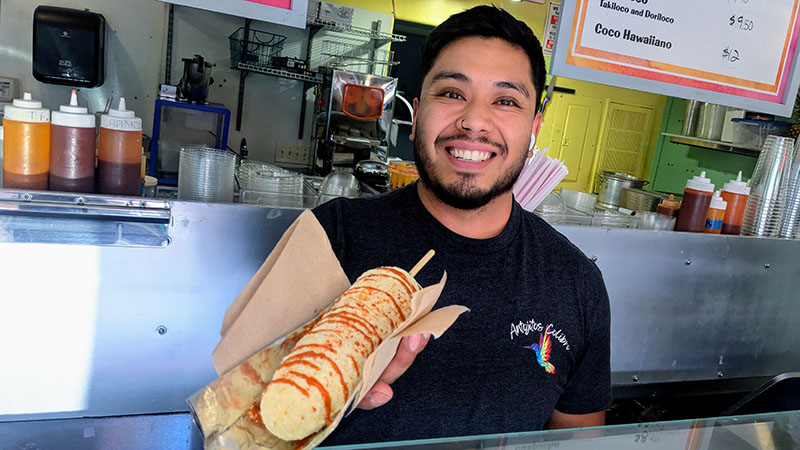A Mexican corn-on-the-cob treat with history.
Have you heard the history of corn? It’s intrinsically connected to the history of Mexico. According to researchers, corn was invented — yes, conjured up and carefully harvested — by the Aztec civilization nearly 7,000 years ago, from a grain (though scientists now classify it as a fruit). While it became known as maize to the Indigenous people outside of the region, and eventually the colonizing Spaniards, in the native language of Nahuatl, the actual corn on the cob was called “elote.”
Northern Nevadans may be familiar with elote as a street food and snack. Boiled or grilled, the corn on the cob is then traditionally slathered with mayonnaise (which serves as a binding agent) and covered with Cotija cheese and chili powder or oil. That’s it. Go to a local mercado to buy husked corn then prepare it yourself, or head to one of the several Mexican eateries around Reno-Tahoe to find it.
Antojitos Colibrí on Wells Avenue in Reno is one such location. At this family-owned ice cream, smoothie, and raspados (similar to Italian shaved ice) shop in Midtown, elotes are popular. Even though the business has its own Cotija and Parmesan cheese blend to cover a portion of the corn on the cob, Mauricio Muñoz, the son of owners Maria Elena and Benjamin, shares that they actually try to accommodate customer preferences, too. Don’t want mayo or chili? Let them know. Certain items can be left off or substituted — Mexican crema (similar to sour cream) instead of mayo, for example.
“We sell a lot of elotes because it brings up memories of people’s childhoods in Mexico or of their travels there,” says Muñoz, adding that some folks even ask for diced cucumbers or lime wedges on the side because that’s how they would eat it. “It gives them a sense of home.”
If you order elote, be prepared for it to be a hot, prepared snack you eat with your hands. Similarly, be careful with your hands if you order its cousin, the esquite, a treat with similar ingredients but no cob, usually served in a cup layered with the customary ingredients. Most locations serve both. However, Muñoz shares that some places use canned instead of fresh corn (ask when you order). He emphasizes that at Antojitos Colibrí, the corn used in esquite always is shaved right off the cob just before serving.
“It’s about offering the best customer experience and presentation,” he says.
Elote at Home
If you plan to make your own elote, there are various ways to do so:
- Boil or grill the corn on the cob. Some recipes recommend smearing butter over it during the grilling process. Aim for a nice char.
- Spread a creamy mixture over the cob. Mayonnaise is the most popular ingredient, Mexican crema is another, or you can use a combination of both. If you have dietary restrictions, you may be able to substitute Greek yogurt or sour cream.
- Cover all or portions of the cob with Cotija cheese (sprinkling is common). Blend with Parmesan, feta, or Romano to add sharper flavors.
- Top with chili powder, oil, and/or a squeezed lime wedge. Antojitos Colibrí’s owners swirl Valentina hot sauce on theirs; some folks add a dash of paprika.
RESOURCES
Find prepared elote at these local businesses:
Antojitos Colibrí
880 S. Wells Ave., Reno
775-513-0623 · Find Antojitoscolibri on Instagram
La Estación Neveria & Snacks
1185 California Ave., Reno
775-622-4547 · Find Laestacionco on Instagram
Paleteria La Michoacana
1295 E. Moana Lane, Ste. C, Reno
775-470-5026 · Orderpaleterialamichoacana1.com


